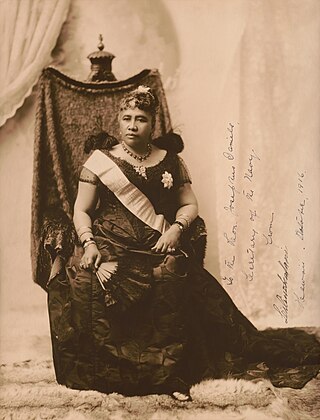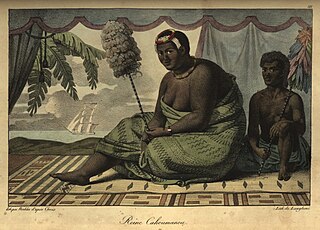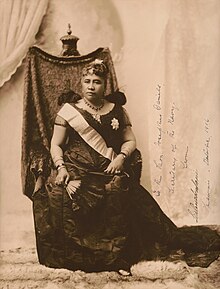
Liliʻuokalani was the only queen regnant and the last sovereign monarch of the Hawaiian Kingdom, ruling from January 29, 1891, until the overthrow of the Hawaiian Kingdom on January 17, 1893. The composer of "Aloha ʻOe" and numerous other works, she wrote her autobiography Hawaiʻi's Story by Hawaiʻi's Queen during her imprisonment following the overthrow.

Hawaii's Story by Hawaii's Queen is a book written by Queen Liliʻuokalani, the last monarch of the Kingdom of Hawaiʻi. It was first published in 1898, five years after the overthrow of the Kingdom. In it, Liliʻuokalani gives her account of her upbringing, her accession to the throne, the overthrow of her government by pro-American forces, her appeals to the United States to restore the Hawaiian monarchy, and her arrest and trial following an unsuccessful 1895 rebellion against the Republic of Hawaiʻi.
The history of Hawaii describes the era of human settlements in the Hawaiian Islands. The islands were first settled by Polynesians sometime between 1000 and 1200 AD forming the modern population of Native Hawaiians. Hawaiian civilization was isolated from the rest of the world for at least 500 years.

Kapu is the ancient Hawaiian code of conduct of laws and regulations. The kapu system was universal in lifestyle, gender roles, politics and religion. An offense that was kapu was often a capital offense, but also often denoted a threat to spiritual power, or theft of mana. Kapus were strictly enforced. Breaking one, even unintentionally, often meant immediate death, Koʻo kapu. The concept is related to taboo and the tapu or tabu found in other Polynesian cultures. The Hawaiian word kapu is usually translated to English as "forbidden", though it also carries the meanings of "keep out", "no trespassing", "sacred", "consecrated", or "holy".

Kaʻahumanu was queen consort and acted as regent of the Kingdom of Hawaiʻi as Kuhina Nui. She was the favorite wife of King Kamehameha I and also the most politically powerful, and continued to wield considerable power as co-ruler in the kingdom during reigns of his first two successors.

Washington Place is a Greek Revival palace in the Hawaii Capital Historic District in Honolulu, Hawaii. It was where Queen Liliʻuokalani was arrested during the overthrow of the Hawaiian Kingdom. Later it became the official residence of the governor of Hawaii. In 2007, it was designated as a National Historic Landmark. The current governor's residence was built in 2008 behind the historic residence, and is located on the same grounds as Washington Place.

Ruth Ke‘elikōlani, or sometimes written as Luka Ke‘elikōlani, also known as Ruth Ke‘elikōlani Keanolani Kanāhoahoa or Ruth Keanolani Kanāhoahoa Ke‘elikōlani, was a member of the House of Kamehameha who served as Governor of the Island of Hawaiʻi and for a period, was the largest and wealthiest landowner in the Hawaiian islands. Keʻelikōlani's genealogy is controversial. Her mother's identity has never been in question but her grandfather Pauli Kaōleiokū's relationship to Kamehameha I is heavily disputed. While her father has been legally identified as early as 1864, disputes to that lineage continued as late as 1919. As one of the primary heirs to the Kamehameha family, Ruth became landholder of much of what would become the Bernice Pauahi Bishop Estate, funding the Kamehameha Schools.

Robert William Kalanihiapo Wilcox, nicknamed the Iron Duke of Hawaiʻi, was a Native Hawaiian whose father was an American and whose mother was Hawaiian. A revolutionary soldier and politician, he led uprisings against both the government of the Hawaiian Kingdom under King Kalākaua and the Republic of Hawaii under Sanford Dole, what are now known as the Wilcox rebellions. He was later elected the first delegate to the United States Congress for the Territory of Hawaii.

The proposed 1893 Constitution of the Hawaiian Kingdom would have been a replacement of the Constitution of 1887, primarily based on the Constitution of 1864 put forth by Queen Lili'uokalani. While it never became anything more than a draft, the constitution had a profound impact on Hawaiʻi's history: it set off a chain of events that eventually resulted in the overthrow of the Hawaiian Kingdom.

The overthrow of the Hawaiian Kingdom was a coup d'état against Queen Liliʻuokalani, which took place on January 17, 1893, on the island of Oʻahu and led by the Committee of Safety, composed of seven foreign residents and six Hawaiian Kingdom subjects of American descent in Honolulu. The Committee prevailed upon American minister John L. Stevens to call in the U.S. Marines to protect the national interest of the United States of America. The insurgents established the Republic of Hawaii, but their ultimate goal was the annexation of the islands to the United States, which occurred in 1898.

Turbinaria ornata is a tropical brown algae of the order Fucales native to coral reef ecosystems of the South Pacific. Turbinaria ornata is more commonly referred to as crowded sea bells in the US and crowned sea bells worldwide. It can quickly colonize these ecosystems due in part to its method of dispersing by detaching older and more buoyant fronds that travel on surface currents, sometimes in large rafts of many individual thalli, or fronds. Some scientists are investigating whether the increase in density of seaweeds, and a decrease in living coral density, on coral reef ecosystems indicates a change in the health of the reef, focusing studies on this particular species of brown alga.

Limu, otherwise known as rimu, remu or ʻimu is a general Polynesian term for edible plants living underwater, such as seaweed, or plants living near water, like algae. In Hawaii, there are approximately one hundred names for kinds of limu, sixty of which can be matched with scientific names. Hundreds of species of marine algae were once found in Hawaii. Many limu are edible, and used in the cuisine throughout most of Polynesia.

Isabella Aiona Abbott was an educator, phycologist, and ethnobotanist from Hawaii. The first native Hawaiian woman to receive a PhD in science, she became a leading expert on Pacific marine algae.

The Hawaiian Kingdom, or Kingdom of Hawaiʻi, was a sovereign state located in the Hawaiian Islands. The country was formed in 1795, when the warrior chief Kamehameha the Great, of the independent island of Hawaiʻi, conquered the independent islands of Oʻahu, Maui, Molokaʻi and Lānaʻi and unified them under one government. In 1810, the whole Hawaiian archipelago became unified when Kauaʻi and Niʻihau joined the Hawaiian Kingdom voluntarily. Two major dynastic families ruled the kingdom: the House of Kamehameha and the House of Kalākaua.

The Hawaiian rebellions and revolutions took place in Hawaii between 1887 and 1895. Until annexation in 1898, Hawaii was an independent sovereign state, recognized by the United States, United Kingdom, France and Germany with exchange of ambassadors. However, there were several challenges to the reigning governments of the Kingdom and Republic of Hawaii during the 8+1⁄2-year (1887–1895) period.
Na Lani ʻEhā, translated as The Royal Four or The Heavenly Four, refers to the siblings King Kalākaua (1836–1891), Queen Liliʻuokalani (1838–1917), Princess Likelike (1851–1887) and Prince William Pitt Leleiohoku II (1854–1877). All four were composers, known for their patronage and enrichment of Hawaii's musical culture and history. All four of them organized glee clubs. William Pitt Leleiohoku II, the youngest brother who died at age 22, was a guitar master and leader of the Kawaihau Glee Club. Youngest sister Likelike was a musician and a co-founder of the Kaohuokalani Singing Club.

Lili'uokalani Trust is a private operating foundation located in Hawai'i. It executes the Deed of Trust of Hawaiʻi's last ruling monarch, Lili'uokalani, to provide for orphaned and destitute children, with preference given to native Hawaiian children.
Formerly known as Sargassum echinocarpum, Sargassum aquifolium is an abundant brown algae of the order Fucales, class Phaeophyceae, genus Sargassum. In Hawaii, it is commonly known as limu kala. This alga is endemic to Hawaiʻi, one out of the four endemic species of endemic Sargassum.

Sargassum polyphyllum is a species of brown macroalgae or limu (seaweed) in the order Fucales.


















